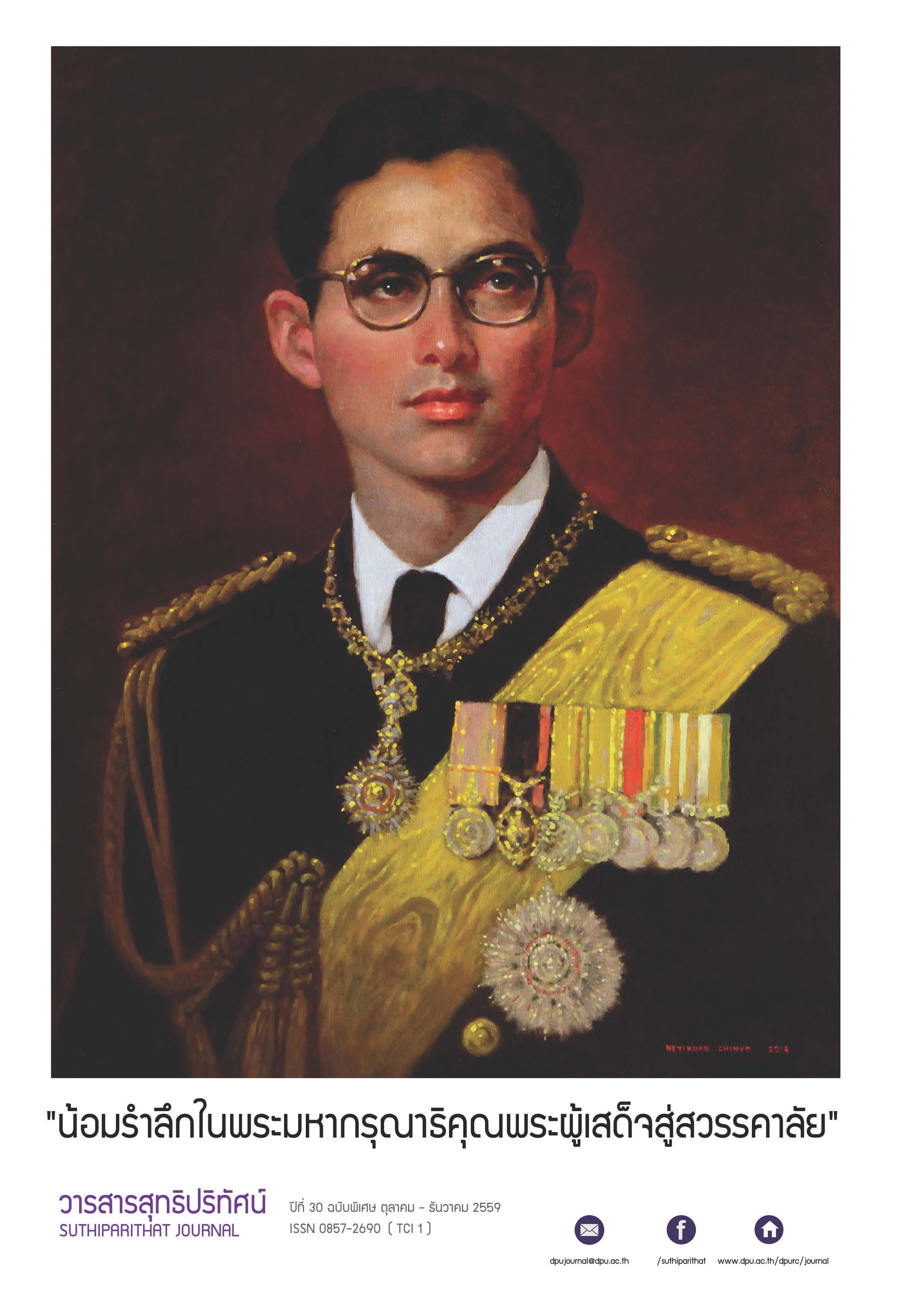การจัดหลักสูตรภาษาอังกฤษเพื่อการสื่อสารโดยใช้ทักษะภาษาการสื่อสารตามสถานการณ์จริงของการทำงานด้านการบัญชี
คำสำคัญ:
ความต้องการ, การบัญชี, ประเภทสถานที่ทำงาน, สถานการณ์สำคัญหลัก, ภาษาอังกฤษเพื่อจุดประสงค์เฉพาะบทคัดย่อ
เนื่องจากความต้องการที่เพิ่มขึ้นสำหรับนักบัญชีไทยที่มีความรู้ความสามารถในการสื่อสารภาษาอังกฤษ บทความนี้จึงนำเสนอกรอบแนวคิดเพื่อการออกแบบวิชาภาษาอังกฤษเพื่อจุดประสงค์เฉพาะ (English for Specific Purposes: ESP) ในหลักสูตรการบัญชีระดับอุดมศึกษา โดยมีวัตถุประสงค์หลักเพื่ออำนวยความสะดวกในกระบวนการเรียนการสอนภาษาอังกฤษ เพื่อจุดประสงค์เฉพาะด้านบัญชีโดยมีความมุ่งหวังที่จะเตรึยมนักเรียนไทยสาขาบัญชีให้มีความรู้ความสามารถภาษาอังกฤษที่ใช้ในสถานที่ทำงานด้าน บัญชี ในการที่จะให้นักเรียนไทยบรรลุเป้าหมาย บทความนี้จึงนำเสนอกรอบแนวคิดเพื่อการออกแบบวิชา “ภาษาอังกฤษสำหรับสถานที่ทำงานด้านบัญชี” โดยมุ่งเน้นทั้งด้านทฤษฎีและด้านปฏิบัติในการวิเคราะห์ สถานการณ์เป้าหมาย (Target Situation Analysis: TSA) ภายใต้แนวของการวิเคราะห์ความต้องการ และเป็นการมุ่งเน้นตั้งแต่ระยะแรกของการสร้างรายวิชาตามสถานการณ์เป้าหมายของสถานที่ทำงานด้านต่างๆ (เช่น ด้านการพูดและการเขียน) ซึ่งรวบรวมมาจากสถานการณ์เป้าหมายของภาษาอังกฤษด้านบัญชีที่ใช้อยู่จริงในโลกและสถานการณ์เป้าหมายดังกล่าวถือว่าเป็นองค์ประกอบที่สำคัญของการออกแบบรายวิชาภาษา อังกฤษสำหรับสถานที่ทำงานด้านบัญชี และโดยภาพรวมจะทำให้เห็นภาพได้ชัดเจนจากข้อมูลที่นำเสนอใน บทความนี้ ซึ่งผู้บริหารหลักสูตรและผู้ปฏิบัติตามหลักสูตรภาษาอังกฤษเพื่อจุดประสงค์เฉพาะจะสามารถ ปรับปรุงวิชาภาษาอังกฤษสำหรับสถานที่ทำงานด้านบัญชี ทั้งแง่มุมด้านทฤษฎีและมุมมองอื่นที่ครอบคลุม หลายๆด้านซึ่งเกี่ยวข้องกับขั้นตอนของการดำเนินการ ประเด็นปัญหาด้านการเรียนการสอนและการพัฒนา วิชาภาษาอังกฤษเพื่อการสร้างรายวิชาภาษาอังกฤษตามสถานการณ์เป้าหมายสำหรับสถานที่ทำงานด้าน บัญชี
References
Abudhahir, R. A. S., Mahdun, M. & Nor A. M. (2014). Needs analysis and material development in English for Specific Purposes in relation to English for Islamic studies. Retrieved March 31, 2016, from http://www.kuis.edu.my/comm2014/eproceedings/C011 Needs analysis and material development in English for specific purposes in relation to English for Islamic studies.pdf
Aguirre, D. E. C. (2013). ASEAN – The rising frontier: Challenges in the accounting profession. The global body for professional accountants. Retrieved May 7, 2016, from http://www.accaglobal.com/content/dam/ACCA_National/vn/events/dean-estelita-asean2013.pdf
Almajed, A. K. & Hamdan, A. (2015). English language and accounting education. Retrieved March 17, 2016,
from http://www.eajournals.org/wp-content/uploads/English-Language-Accountng-Education.pdf
Association of Southeast Asian Nations (2009). ASEAN Mutual Recognition Arrangement (MRA) Framework on
Accountancy Services. Retrieved November 21, 2016, from http://investasean.asean.org/iles/upload/MRAAccountancy(Feb09).pdf
Baleghizadeh, S. & Rahimi, A. H. (2011). Evaluation of an ESP textbook for the students of sociology. Retrieved June 12, 2016, from http://www.academypublication.com/issues/past/jltr/vol02/05/08.pdf
Barati, T., Fatemi, M. A. & Mohammadzadeh, S. (2015). An investigation into the English language needs of bank employees of Saderat Bank in Mashhad. Retrieved April 27, 2016, from http://www.academypublication.com/ojs/index.php/tpls/article/viewFile/tpls050816951702/341
Benavent, G. T. & Penamaria, S. (2011). Use of authentic materials in the ESP classroom. Retrieved June 9, 2016, from http://www.webmail.encuentrojournal.org/textos/Torregrosa_2.pdf
Bingol, M. A., Celik, B., Mart, C. T. & Yildiz, N. (2014). The significance of ESAP (English for Specific Academic
Purpose) needs analysis for subject instructors in Engineering Faculty. Retrieved June 9, 2016, from http://www.wjeis.org/FileUpload/ds217232/File/10b.celik.pdf
Brooks, M. (2014) The role of vocabulary in English for Specific Purposes (ESP) teaching and learning: Considerations for Asia University. Retrieved May 25, 2016, from http://www.i-repository.net/contents/asiau/.pdf
Brown, A. & Chatterjee, B. (2012). Embedding English language in an accounting subject: A case of interactive
interdisciplinary collaboration and learning. Retrieved March 17, 2016, from http://www.ejbest.org/upload/eJBEST_Chatterjee_Brown_2012_1.pdf
Brunton, M. (2009). An account of ESP with possible future directions. Retrieved March 31, 2016, from http://www.esp-world.info/articles_24/Anaccount of EST.pdf
Burns, A., Joyce, H. & Gollin, S. (1996). I see what you mean: Using spoken discourse in the classroom.
National Centre for English Language Teaching and Research. Macquarie University.
Burns, A. & Moore, S. (2008). Non-English-speaking background accountants and professional communication.
Retrieved March 17, 2016, from http://www.ameprc.mq.edu.au/docs/prospect_journal/volume_23_no_2/NonEnglishSpeaking.pdf
Dudley-Evans, T. & St John, M. J. (1998). Developments in English for Specific Purposes: A multi-disciplinaryapproach. Cambridge: Cambridge University Press.
Frendo, E. & Mahoney, S. (2011). English for accounting (5th ed.). Oxford: Oxford University Press.
Gray, F. E. (2009). Making yourself heard: Oral communication in the global accountancy workplace. Retrieved
April 10, 2016, from https://www.academia.edu/971345/Making_yourself_heard_Oral_communication_in_the_global_accountancy_workplace.
Haan, J. & Mallett, K. (2010). From the classroom to the boardroom: Grammar and style across genres in ESL
professional writing. Retrieved May 7, 2016, from http://www.tesol.org/docs/books/bk_CP_effectiveSLwriting_639
Hutchinson, T. & Waters, A. (1987). English for Specific Purposes: A learning centred approach. Cambridge:
Cambridge University Press.
Kountur, R. & Huo, Y. (2013). The qualifications of accounting profession as required by employer. Retrieved
March 17, 2016, from https://www.academia.edu/4295091/the_qualifications_of_accounting_profession_as_required_by_employer.
Maryam, D. T. & Sara, H. (2014). Evaluation of ESP textbooks: Evidence from ESP textbook of computer
engineering major. Retrieved March 13, 2016, from http://www.consortiacademia.org/index.php/ijrsll/article/view/469
Mizne, C. A. (1997). Teaching sociolinguistic competence in the ESL classroom. Retrieved April 25, 2016, from
http://trace.tennessee.edu/cgi/viewcontent.cgi?article=1019&context=utk_interstp2
Mohammadi, S. M. & Moghadam, A. S. (2015). A comparative evaluation of two ESP textbooks for students of
engineering: Merits and demerits. Retrieved March 25, 2016, from http://www.languageinindia.com/feb2015/seyedtextbookevaluation2.pdf
Nunan, D. (1988). The Learner-centred Curriculum. Cambridge: Cambridge University Press.
Paltridge, B. (2001). Genre and the Language Learning Classroom. Ann Arbor: The University of Michigan Press.
Pichayasupakoon, T. (2014). The impact of the ASEAN Economic Community (AEC) on the recruitment of accountants: A case study of listed firms on the Stock Exchange of Thailand. Silpakorn University Journal of Social Sciences, Humanities, and Arts, 14(2),1-24.
Rahman, M. (2015). English for Specific Purposes (ESP): A holistic review. Retrieved March 25, 2016, from
http://www.hrpub.org/download/20150101/UJER4-19503020.pdf
Richards, J. C. (2001). Curriculum Development and Syllabus Design. Cambridge: Cambridge University Press.
Robinson, P. (1991). ESP today: A practitioner’s guide. New York: Prentice Hall.
Suttipun, M. (2012). The relationship between the readiness of Thai accounting students for the international
education standards and their competency: A survey study of southern Thailand.Retrieved March 25, 2016, from http://stmlportal.net/ictom04/papers/P20.pdf
Suttipun, M. (2014). The readiness of Thai accounting students for the ASEAN Economic Community: An
exploratory study. Asian Journal of Business and Accounting, 7(2), 139-154.
Swales, J. M. (1990). Genre analysis: English in academic and research settings. Cambridge: Cambridge University Press.
Vicic, P. (2011). Preparing materials for ESP teaching. Inter Alia, 2, 107-120.
Wu, R. Y. F. & Chin, J. S. (2010). An investigation into the English language needs of banking and finance professionals in Taiwan. In Proceedings of the 12th Academic Forum on English Language Testing in Asia, Taipei (pp. 73-87).
Yates, J. & Orlikowski (1992). Genres of organizational communication: A structural approach to studying communication and media. Retrieved March 17, 2016, from https://www.ics.uci.edu/~corps/phaseii/YatesOrlikowski-GenresOrgComm-AMR.pdf
Zivkovic, S. (2016). The ESP technology-supported learning environment. Retrieved June 9, 2016, from http://lib.euser.org/res/jrn/ejser/jan_apr_16/Zivkovic.pdf
Downloads
เผยแพร่แล้ว
How to Cite
ฉบับ
บท
License
เนื้อหาและข้อมูลในบทความที่ลงตีพิมพ์ในวารสารสุทธิปริทัศน์ ถือเป็นข้อคิดเห็นและความรับผิดชอบของผู้เขียนบทความโดยตรงซึ่งกองบรรณาธิการวารสาร ไม่จำเป็นต้องเห็นด้วย หรือร่วมรับผิดชอบใดๆ
บทความ ข้อมูล เนื้อหา รูปภาพ ฯลฯ ที่ได้รับการตีพิมพ์ในวารสารสุทธิปริทัศน์ ถือเป็นลิขสิทธิ์ของวารสารสุทธิปริทัศน์หากบุคคลหรือหน่วยงานใดต้องการนำทั้งหมดหรือส่วนหนึ่งส่วนใดไปเผยแพร่ต่อหรือเพื่อกระทำการใด ๆ จะต้องได้รับอนุญาตเป็นลายลักษณ์อักษรจากวารสารสุทธิปริทัศน์ก่อนเท่านั้น






